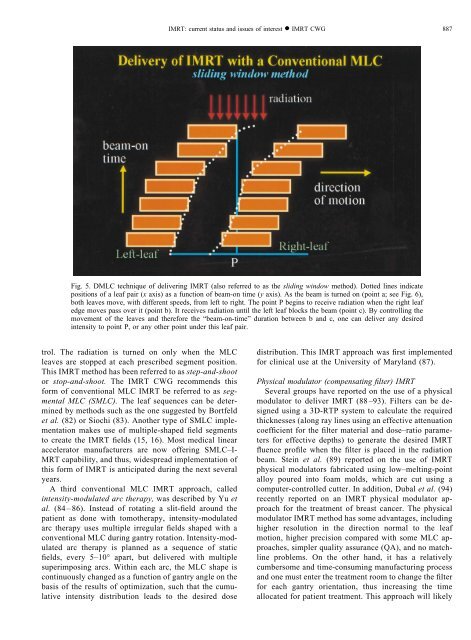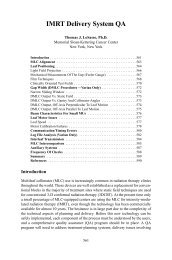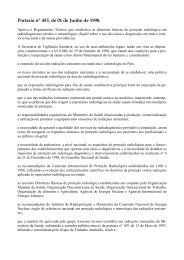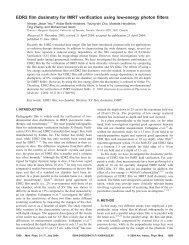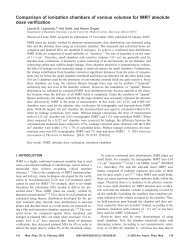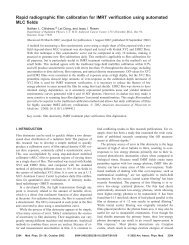intensity-modulated radiotherapy: current status and issues
intensity-modulated radiotherapy: current status and issues
intensity-modulated radiotherapy: current status and issues
Create successful ePaper yourself
Turn your PDF publications into a flip-book with our unique Google optimized e-Paper software.
IMRT: <strong>current</strong> <strong>status</strong> <strong>and</strong> <strong>issues</strong> of interest ● IMRT CWG<br />
887<br />
Fig. 5. DMLC technique of delivering IMRT (also referred to as the sliding window method). Dotted lines indicate<br />
positions of a leaf pair (x axis) as a function of beam-on time (y axis). As the beam is turned on (point a; see Fig. 6),<br />
both leaves move, with different speeds, from left to right. The point P begins to receive radiation when the right leaf<br />
edge moves pass over it (point b). It receives radiation until the left leaf blocks the beam (point c). By controlling the<br />
movement of the leaves <strong>and</strong> therefore the “beam-on-time” duration between b <strong>and</strong> c, one can deliver any desired<br />
<strong>intensity</strong> to point P, or any other point under this leaf pair.<br />
trol. The radiation is turned on only when the MLC<br />
leaves are stopped at each prescribed segment position.<br />
This IMRT method has been referred to as step-<strong>and</strong>-shoot<br />
or stop-<strong>and</strong>-shoot. The IMRT CWG recommends this<br />
form of conventional MLC IMRT be referred to as segmental<br />
MLC (SMLC). The leaf sequences can be determined<br />
by methods such as the one suggested by Bortfeld<br />
et al. (82) or Siochi (83). Another type of SMLC implementation<br />
makes use of multiple-shaped field segments<br />
to create the IMRT fields (15, 16). Most medical linear<br />
accelerator manufacturers are now offering SMLC–I-<br />
MRT capability, <strong>and</strong> thus, widespread implementation of<br />
this form of IMRT is anticipated during the next several<br />
years.<br />
A third conventional MLC IMRT approach, called<br />
<strong>intensity</strong>-<strong>modulated</strong> arc therapy, was described by Yu et<br />
al. (84– 86). Instead of rotating a slit-field around the<br />
patient as done with tomotherapy, <strong>intensity</strong>-<strong>modulated</strong><br />
arc therapy uses multiple irregular fields shaped with a<br />
conventional MLC during gantry rotation. Intensity-<strong>modulated</strong><br />
arc therapy is planned as a sequence of static<br />
fields, every 5–10° apart, but delivered with multiple<br />
superimposing arcs. Within each arc, the MLC shape is<br />
continuously changed as a function of gantry angle on the<br />
basis of the results of optimization, such that the cumulative<br />
<strong>intensity</strong> distribution leads to the desired dose<br />
distribution. This IMRT approach was first implemented<br />
for clinical use at the University of Maryl<strong>and</strong> (87).<br />
Physical modulator (compensating filter) IMRT<br />
Several groups have reported on the use of a physical<br />
modulator to deliver IMRT (88–93). Filters can be designed<br />
using a 3D-RTP system to calculate the required<br />
thicknesses (along ray lines using an effective attenuation<br />
coefficient for the filter material <strong>and</strong> dose–ratio parameters<br />
for effective depths) to generate the desired IMRT<br />
fluence profile when the filter is placed in the radiation<br />
beam. Stein et al. (89) reported on the use of IMRT<br />
physical modulators fabricated using low–melting-point<br />
alloy poured into foam molds, which are cut using a<br />
computer-controlled cutter. In addition, Dubal et al. (94)<br />
recently reported on an IMRT physical modulator approach<br />
for the treatment of breast cancer. The physical<br />
modulator IMRT method has some advantages, including<br />
higher resolution in the direction normal to the leaf<br />
motion, higher precision compared with some MLC approaches,<br />
simpler quality assurance (QA), <strong>and</strong> no matchline<br />
problems. On the other h<strong>and</strong>, it has a relatively<br />
cumbersome <strong>and</strong> time-consuming manufacturing process<br />
<strong>and</strong> one must enter the treatment room to change the filter<br />
for each gantry orientation, thus increasing the time<br />
allocated for patient treatment. This approach will likely


